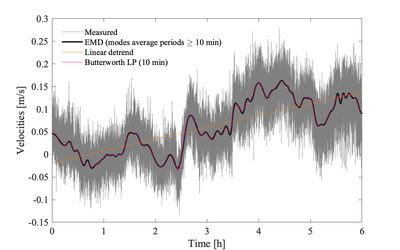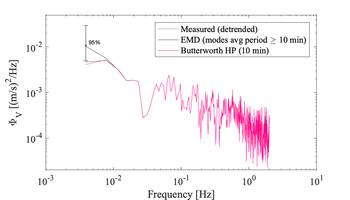Decomposing velocity measurements: Difference between revisions
m Added lots of pics |
|||
| Line 7: | Line 7: | ||
==Methods for detrending== | ==Methods for detrending== | ||
[[File:Long timeseries.png|400px|thumb|Measured velocities at 4 Hz from an [[Acoustic-Doppler Velocimeters]] have been detrended using three different techniques. Empirical modal decomposition (EMD) <ref name="Wuetal_PNAS">{{Cite journal | |||
|authors=Zhaohua Wu, Norden E. Huang, Steven R. Long, and Chung-Kang Peng | |||
|journal_or_publisher=PNAS | |||
|paper_or_booktitle=On the trend, detrending, and variability of nonlinear and nonstationary time series | |||
|year=2007 | |||
|doi=10.1073/pnas.0701020104 | |||
}}</ref>, linear trend, and a 2nd order low-pass Butterworth filter. A cut-off period of 10 min was targeted by both the filter and EMD]] | |||
There is no exact definition for what consists of a "trend", nor any set algorithm for identifying the trend. The following techniques can be used for detrending <ref name=Wuetal_PNAS/>: | There is no exact definition for what consists of a "trend", nor any set algorithm for identifying the trend. The following techniques can be used for detrending <ref name=Wuetal_PNAS/>: | ||
| Line 15: | Line 22: | ||
The first two methods presume the original time series is [[Stationarity|stationary]] and linear, while the third is adaptive and applicable to nonlinear and non-stationary timeseries. | The first two methods presume the original time series is [[Stationarity|stationary]] and linear, while the third is adaptive and applicable to nonlinear and non-stationary timeseries. | ||
==Application to measured velocities== | ==Application to measured velocities== | ||
| Line 28: | Line 29: | ||
* short bursts that are typically at most 2-3x the expected largest turbulence time scales. | * short bursts that are typically at most 2-3x the expected largest turbulence time scales. | ||
As a rule of thumb, turbulence estimates from the inertial subrange of velocity rely on 5 to 15 min long [[Segmenting datasets|segments]]. The act of chopping a timeseries into smaller subsets, i.e., segments, is effectively a form of low-pass (box-car) filtering. | As a rule of thumb, turbulence estimates from the inertial subrange of velocity rely on 5 to 15 min long [[Segmenting datasets|segments]]. | ||
==Segmenting== | |||
The act of chopping a timeseries into smaller subsets, i.e., segments, is effectively a form of low-pass (box-car) filtering. | |||
The question of how to detrend becomes less important than how best to [[Segmenting datasets|segments]] the timeseries. This step dictates the minimum burst duration when setting-up your equipment. | The question of how to detrend becomes less important than how best to [[Segmenting datasets|segments]] the timeseries. This step dictates the minimum burst duration when setting-up your equipment. | ||
= | <div><ul> | ||
<li style="display: inline-block; vertical-align: top;"> [[File:Short timeseries.png|thumb|none|350px|Zoom of the first 512 s of the measured velocities shown above]] | |||
</li> | |||
<li style="display: inline-block; vertical-align: top;"> [[File:Short_spectra.png|thumb|none|350px|Example velocity spectra before and after different detrending techniques]] </li> | |||
</ul></div> | |||
==Notes== | ==Notes== | ||
Revision as of 21:04, 29 November 2021
{{#default_form:Processing}}
{{#arraymap:
Velocity point-measurements
|,|x||}}
{{#arraymap:level 2 segmented and quality controlled|,|x||}}
The quality-controlled velocities can be detrended before being further analysed to determine mean flow past the sensor and surface wave statistics. These quantities are necessary for later choosing the appropriate inertial subrange model for spectral fitting.
Methods for detrending

There is no exact definition for what consists of a "trend", nor any set algorithm for identifying the trend. The following techniques can be used for detrending [1]:
- Linear trend removal
- Low-pass linear filters
- Empirical modal decomposition
The first two methods presume the original time series is stationary and linear, while the third is adaptive and applicable to nonlinear and non-stationary timeseries.
Application to measured velocities
Measurements are typically collected in the following two ways:
- continuously, or in such long bursts that they can be considered continuous
- short bursts that are typically at most 2-3x the expected largest turbulence time scales.
As a rule of thumb, turbulence estimates from the inertial subrange of velocity rely on 5 to 15 min long segments.
Segmenting
The act of chopping a timeseries into smaller subsets, i.e., segments, is effectively a form of low-pass (box-car) filtering.
The question of how to detrend becomes less important than how best to segments the timeseries. This step dictates the minimum burst duration when setting-up your equipment.
Notes
- ↑ 1.0 1.1 {{#arraymap:Zhaohua Wu, Norden E. Huang, Steven R. Long, and Chung-Kang Peng|,|x|x|, |and}}. 2007. On the trend, detrending, and variability of nonlinear and nonstationary time series. PNAS. doi:10.1073/pnas.0701020104


